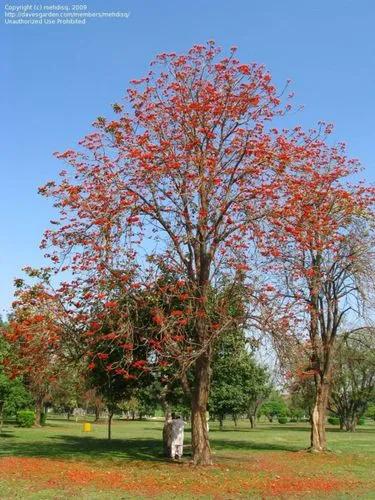is a large evergreen coniferous tree in the plant family Araucariaceae. It is found naturally in south-east Queensland Australia and two small disjunct populations in north eastern Queensland's World Heritage listed Wet Tropics. There are many old planted specimens in New South Wales, and around the Perth, Western Australia metropolitan area. They can grow up to 30–45 m (98–148 ft). The tallest presently living is one in Bunya Mountains National Park, Queensland which was reported by Robert Van Pelt in January 2003 to be 169 feet (51.5 m) in height.[2] The bunya pine is the last surviving species of the Section Bunya of the genus Araucaria. This section was diverse and widespread during the Mesozoic with some species having cone morphology similar to A. bidwillii, which appeared during the Jurassic. Fossils of Section Bunya are found in South America and Europe. The scientific name honours the botanist John Carne Bidwill, who came across it in 1842 and sent the first specimens to Sir William Hooker in the following year.
False Monkey Puzzle Tree Care
Araucaria Bidwillii



he bunya, bonye, bunyi or bunya-bunya in various Australian Aboriginal languages was colloquially named the Bunya Pine by Europeans. However, Araucaria bidwillii is not a pine tree (of the genus Pinus). It belongs to the same genus as the monkey puzzle tree (Araucaria araucana)[citation needed] and is sometimes referred to as the "false monkey puzzle tree". The Bunya tree grows to a height of 30–45 metres, and the cones, which contain the edible kernels, are the size of soccer balls. The 1889 book The Useful Native Plants of Australia records that "The cones shed their seeds, which are two to two and a-half inches long by three-quarters of an inch broad ; they are sweet before being perfectly ripe, and after that resemble roasted chestnuts in taste. They are plentiful once in three years, and when the ripening season arrives, which is generally in the month of January. The trees pollinate in South East Queensland in September/October and the cones fall 17 to 18 months later in late January to early March from the coast to the current Bunya Mountains. When there is heavy rainfall or drought, pollination may varyThe bunya, bonye, bunyi or bunya-bunya tree produces edible kernels. The ripe cones fall to the ground. Each segment contains a kernel in a tough protective shell, which will split when boiled or put in a fire. The flavour of the kernel is similar to a chestnut.[citation needed] The cones were a very important food source for native Australians – each Aboriginal family would own a group of trees and these would be passed down from generation to generation. This is said to be the only case of hereditary personal property owned by the Aboriginal people. After the cones had fallen and the fruit was ripe, large festival harvest would sometimes occur, between two and seven years apart. The people of the region would set aside differences and gather in the Bon-yi Mountains (Bunya Mountains) to feast on the kernels. The local people, who were bound by custodial obligations and rights, sent out messengers to invite people from hundreds of kilometres to meet at specific sites. The meetings involved Aboriginal ceremonies, dispute settlements and fights, marriage arrangements and the trading of good
How to Care for the Plant

Popularity

152 people already have this plant 22 people have added this plant to their wishlists
Discover more plants with the list below
Popular articles






